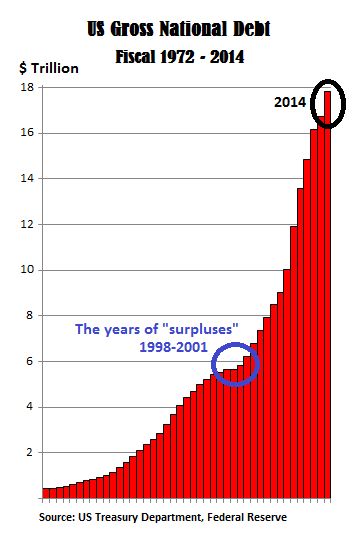The Ever Ballooning US Gross National Debt
During fiscal 2014, ended September 30, the US Government piled $1.086 trillion in new gross national debt on top of the existing mountain to bring it to $17.824 trillion. Money that the US government owes the Chinese, Japanese, Russians, and so on, and a large number of US investors too, including the Social Security “Trust Fund.”
Some of these entities had no choice but to accept US debt. Others made conscious decisions to buy it, betting that this debt, which is supposed to be their most conservatively invested asset, will somehow turn into a good investment albeit with a very low yield that ranges currently from near zero for 13-week T-bills to 2.95% for 30-year T-bonds. Those folks holding Treasuries with longer-dated maturities are praying that their asset won’t be eaten up by a bout of inflation in the future, and they’re praying even harder that yields won’t rise anytime soon because that would actually cut the value of their asset. If both happened at the same time…. Better not even contemplate this scenario.
Back in October, I wondered how the debt could jump $1.086 trillion in a fiscal year when the government claimed that it had reduced the “deficit” to $483 billion. And this is what the Gross National debt looked like through fiscal 2014 with its near exponential growth since 2001, a bipartisan fiasco without equal during my lifetime:
Even the so-called “surpluses” between 1998 and 2001, which exceeded 2% of GDP at one point and should have brought down the gross national debt, instead increased it in every one of those four years, by a total of $394 billion. Deficits as figured by government accounting never quite match reality. And that reality is the increase in debt.
And now, that debt jumped by another $181 billion over the first two months of fiscal 2015 and hit the next milestone: $18 trillion. Or to be precise, $18,005,549,328,561. A glorious moment to celebrate.
But the joys of celebration are wearing thin. Hitting that trillion-mark has become all too routine in recent American budgetary history: it took till 1982 to hit it the first time. It took the following 20 years to hit the next five trillion-marks. But then, we hit trillion-marks 12 times in 14 years! With consequences for generations to come. But hey, the volcano hasn’t erupted yet. So let’s not worry about it. Let’s just party on.
In these crazy times of ours, it always pays to be cautious when other investors get greedy. Read… I’ve Been Thinking About How the Current Madness Will End
Enjoy reading WOLF STREET and want to support it? You can donate. I appreciate it immensely. Click on the mug to find out how:
![]()




This is one of very few websites still talking about the debt. There seems to be a fantasy that the government is honest, that they use sensibile accounting practices. There seems to be a fantasy that last year’s deficit was ONLY $450,000,000,000.00. Problem solved! What kind of idiots are we.
Thanks, Wolf, for sharing the truth.
The creditors are suckers for still accepting America’s debts. Americans are getting the better part of the deal.
Well, a lot of these creditors are Americans, directly or indirectly: US bond funds that people have in their retirement accounts… big institutional investors or even corporations like Apple that need to park a few billion somewhere so it won’t get lost in the next shuffle…. regular retail investors who can buy Treasuries online directly from the Treasury. Treasuries are used for collateral in the financial sector. $18 trillion is a lot – so they’re spread around. I bet you’re exposed to them too :-]
The reason for mushrooming debt despite a “shrinking” deficit is the same as why those “surpluses” were pure delusion: the “unified budget” counts things that make the income look better but continues to hide all those nasty “black ops” (try finding the line item for all the NSA’s good gear, for example) and unfunded liabilities. LBJ was almost as much of a shitbag as Tricky Dick, and that’s sayin’ sumthin.
NotSoSure – Even if “average Americans” were actually getting dick for $18 trill of debt, it’s still not a good deal; the interest costs alone are a highly unproductive misallocation of resources, and as per my comment above, even more of it goes to things that are not only not beneficial, but in many cases, actively detrimental to most Americans.
The one question that is never answered satisfactorily:
To WHOM owe we this pile of debt? Which party/parties will
will stand up at the day of reckoning and claim this stash?
Another well written article!
It seems to me that “the system” is now locked in on autopilot and with an incapacitated crew; just like the Malaysian airliner.
The economy will continue to fly until it runs out of fuel. What that “running out of fuel” will look like, I do not know. But I am fairly certain absolutely nothing is going to be done to try and take control back in the cockpit.
The corrupt leaders of the past would be green with envy at today’s corrupt leaders, who have extended their rein far longer than it should go by the use of worthless currency, which makes debt meaningless.
Unless its our personal debt, owed by regular people, then every penny counts.
The level of debt subject to the limit or the level of the debt-to-GDP ratio, have nothing to do with the ability of the US Government to pay its debts because the US has a non-convertible fiat currency with a floating exchange rate and no debts in any foreign currency. Since it is the currency issuer it can always pay its debts by creating new money which it does now through the interaction of the Fed and the Treasury.
, a fact admitted by Greenspan and Bernanke